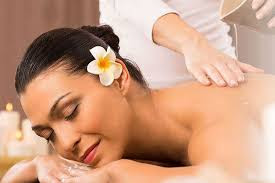Have you ever heard many advertisements for oil
massage and massage therapy in newspapers, T.V. even in mobile call spam calls, etc to nice talking and attracting the people as customers for oil massage?
No one can deny, the oil massage is very good
for health as it gives freshness, a stress-free mind, and an energetic environment to the body to perform well. But just applying oil in the body with sweet talk is enough?
Some people may say yes. But the majority of people will be saying NO. Why? Because
applying oil over the body is a technique and if it is applied correctly then,
only it works otherwise it may harm too.
In Ayurvedic terminology, it is called as “Abhyanga Technique”. Comfortable environment need for both the
person who is taking Abhyanga and those who giving Abhyanga.
It is well said
that the Abhyanga should be performed on the floor, then one should feel
comfortable squatting or sitting in Sddhasana/ Siddha yoni asana position.
After the Abhyanga, both people should feel recharged.
It is also to be noted that oil should not be
cold when applied to the person’s skin. Or it will shock them preventing
relaxation. Also, the practitioner’s hand should not be cold Rubbing the hands
together will bring warmth and healing energy. Working the muscles relax and
tones them, while working the bones strengthens the skeletal system. Duration
is also important in abhyanga, for instance, 6 days to 6-month babies only 15
minutes; Infants (until 3 years) for 15-20 minutes; 03 to 18 years requires 30 -
45 minutes; 18 to 40 years person requires abhyanga for 40 – 45 minutes and 40
+ years people need according to their health conditions. For a person with
diseases, only 15-20 minutes is enough.
In Ayurveda, there are four techniques have been
suggested for Abhyanga. These re are –
1.
Tapping- It is introduced to inform the body it is about to receive
abhyanga. It is increasing circulation and strengthens muscles. Tapping is
done with open palms and relaxed fingers.
2.
Kneading- It is done as if kneading dough. It increases the energy flow,
relaxes, removes stress, and rejuvenates the body.
3.
Rubbing- It is best done with oil according to one's doshas. (Only Kapha
can have a dry abhyanga). otherwise, dry rubbing creates friction and aggravates
Vayu. Gentle rubbing is more relaxing, whereas vigorous rubbing creates passive
exercise. Oil rubbed under the joints works the lymph system. Circular motion
on specific points (marmas) releases growth hormones. Comfortable pressure will
always be applied during abhyanga. Creating a rhythm is another important part
of the rubbing technique.
4.
Squeezing- It is the fourth phase of the abhyanga process. Both hands are
used to squeeze all the areas that were rubbed using comfortable pressure. Cross
movement (hands slide in the opposite directions) is also employed. Pressing special
points (marmas) is also advised. Applying oil to the fingernails is the final
stage in this process. Fingers are squeezed one at a time; this ensures that
the oil seeps into the cracks between the nails and the cuticle.
Some practitioners suggest that a healthy person
can receive the circular portion of the abhyanga both clockwise and counterclockwise, while the person with an illness can receive only clockwise abhyanga. When the session of abhyanga is completed, it
is advised that both practitioner and client lie in the corpse asana pose and
rest for some time. After that sadhana (meditation) is recommended. Aum, the
Gayatri mantra, personal mantra, or prayer may be used.
Cautions: Oil application over the body must be done by trained health workers or experienced practitioners or otherwise it may worsen the condition of the health...
Stay healthy, stay safe...






No comments:
Post a Comment